We explain what they are and what the properties of matter are. General, specific, intensive and extensive properties.

What are the properties of matter?
Matter is everything that occupies an observable part of space and it has a certain amount of energy associated with it. This makes it have a spatial location, directly affected by the passage of time. In other words, matter is what the universe is made of, and which can also be measured in some way.
The matter is everything that has mass occupies a place in space, remains in time and can be measurable with some measuring instrument.
The properties of matter are divided into general (common properties that all bodies have and do not allow one substance to be differentiated from another) and specific (intrinsic properties of matter that allow one body to be differentiated from another).
General properties of matter

The general properties of matter are:
- Extension Space or volume occupied by a certain body.
- Mass. Amount of matter contained in a body.
- Inertia. Ability to maintain its state of rest or movement without the intervention of a force.
- Porosity. Space that exists between the particles of a body.
- Divisibility. Ability to subdivide matter into smaller parts.
- Weight. Force exerted by gravity on a material body.
Continue in: General properties of matter
Specific properties of matter
The specific properties of matter are classified as:
Physical properties (define the form and state in which matter can be measured):
- Density. Amount of mass per unit of volume. Each material has its own density.
- Melting point. Temperature at which the substance changes from solid to liquid state (it is an intensive property of solid matter).
- Electrical conductivity Capacity of a material to conduct electric current through its structure. There are materials that are good conductors of electricity (such as metals) and insulating materials (such as glass, plastic and wood).
- Thermal conductivity. Degree or extent to which a material can conduct heat. Temperature, material phase changes, and electrical conductivity influence thermal conductivity. Many metals have good thermal conductivity, while polymers do not have good thermal conductivity and materials such as cork are thermal insulators.
- Boiling point Temperature at which the vapor pressure of a liquid equals the pressure surrounding the liquid, causing the liquid to transform into a gas. When the temperature of a liquid exceeds its boiling point, the kinetic energy of its particles increases greatly (which is the energy they have as a result of their movement). The particles will break the surface tension of the liquid due to this increased motion and move into the vapor phase.
Chemical properties (they define the reactivity of matter, that is, when a matter is converted into a new one through a chemical reaction):
- Reactivity Capacity of a substance to react in the presence of another substance.
- Combustibility Capacity of a substance to combust. Combustion is an oxidation reaction that occurs rapidly, and if it gets out of control, it can cause explosions. Fuels, such as gasoline, are substances that have high combustibility.
- Acidity Characteristic of a substance that behaves like an acid. The pH of acids dissolved in water is less than 7, while pure water has pH=7.
- Alkalinity Capacity of a substance to counteract the effect of an acid, that is, to neutralize it.
Extensive and intensive properties of matter

On the other hand, properties can be classified as extensive or intensive:
- Extensive properties They are those in which the measured value resides in the properties of the mass. For example: weight, area, volume and force.
- Intensive properties They are properties that do not depend on mass, that is, they are the same for a small sample as for a large sample. For example: color, flavor, electronegativity, boiling point, melting point and hardness.
References
- «Heat and Thermodynamics» 6th Edition. Mark W. Zemansky, Richard H. Dittman.
- “Principles of Chemistry: the paths of discovery” Atkins, Peter; Jones, Loretta.Ed. Pan American Medical. (2006) ISBN 9789500600804.
- Consult: www.elbibliote.com





